In this article, you’ll learn what is Single Cylinder Engine? Its diagram, parts, working, advantages, and applications all are explained with pictures.
Also, you can download the PDF file at the end of this article.
What is Single Cylinder Engine?
A single-cylinder engine is a combustion engine with only one cylinder in which a piston moves to employ combustion. Typically, single-cylinder engines are used on smaller vehicles and tools due to the fact that only one piston is doing the work.
Given its size, it has the potential to produce a relatively large amount of power. But, this engine is only able to change power output slowly, making it less versatile for larger vehicles. Engines of this type are lightweight and compact, so they are a good choice for tools powered by engines, such as weed whackers.
In addition to their use on motorcycles, it is used in many applications such as go-karts, all-terrain vehicles, radio-controlled vehicles, portable tools, and garden machinery (such as lawnmowers, cultivators, and string trimmers).
Single-cylinder engines are made as both 4-stroke and 2-stroke and have been used in cars and tractors. These engines have a lot of features and advantages. Let’s understand them all below.
Read Also: List of Bike Engine Parts: Their Working and Uses Explained [Pics]
Parts of Single Cylinder Engine
The following are the important parts of single cylinder engine:
- Cylinder
- Piston
- Intake manifold
- Exhaust manifold
- Inlet valve
- Exhaust valve
- Spark plug
- Fuel Injector
- Connecting rod
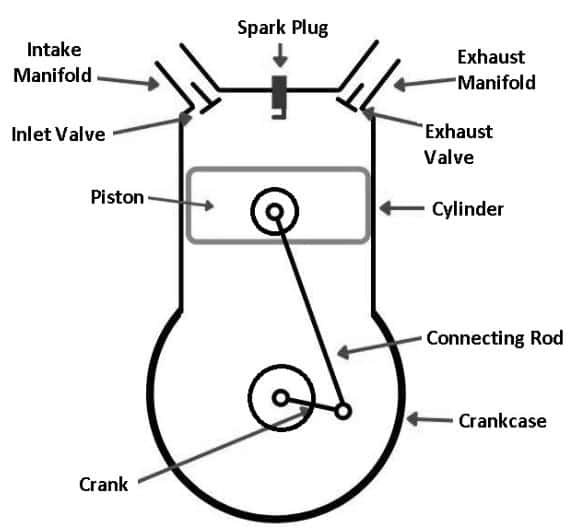
#1 Cylinder
A cylinder is generally made of cast iron. It consists of a piston that moves inside the cylinder to conduct the combustion process.
#2 Piston
A piston is a reciprocating device that reciprocates inside the cylinder. The other end of the piston is attached to the connecting rod and is usually made of aluminum alloy.
#3 Intake Manifold
Through this, the fresh charge is supplied to the cylinder. Intake manifolds distribute charge evenly between the cylinders of multiple-cylinder engines.
#4 Exhaust Manifold
The exhaust manifold is the first area of a vehicle’s exhaust system mounted directly to the engine block. It directs all exhaust gases from all cylinders to the atmosphere.
#5 Inlet Valve
The inlet valve controls the flow of fresh charge into the cylinder. It opens only on the suction stroke to receive the air/fuel mixture and remains closed on other strokes.
#6 Exhaust Valve
The purpose of the exhaust valve is to control the flow of burnt exhaust gases. It opens only on the exhaust stroke to force the burnt air/fuel mixture out of the cylinder and remains closed on other strokes. The camshaft sets the speed of the exhaust valves.
#7 Spark Plug
Spark plugs are used in petrol engines. It consists of two electrodes separated by an air gap, across which a high-tension ignition system discharges, creating a spark to ignite the air-fuel mixture.
#8 Fuel Injector
A fuel injector is used in diesel engines. It is responsible for delivering fuel to the engine cylinders while carefully controlling injection timing, fuel atomization, and other factors.
#9 Connecting Rod
The connecting rod connects the piston to the crankshaft, which helps transfer the combustion pressure to the crankpin. It has bearing parts on both ends, the piston side is called the small end, and the crankshaft side is the large end.
Read Also: What is the function of a piston pin in an engine?
Working of Single Cylinder Engine
The single-cylinder engines are available in two different kinds of configurations, four-stroke, and two-stroke.
Single Cylinder 4-stroke Cylinder (Petrol Engine)
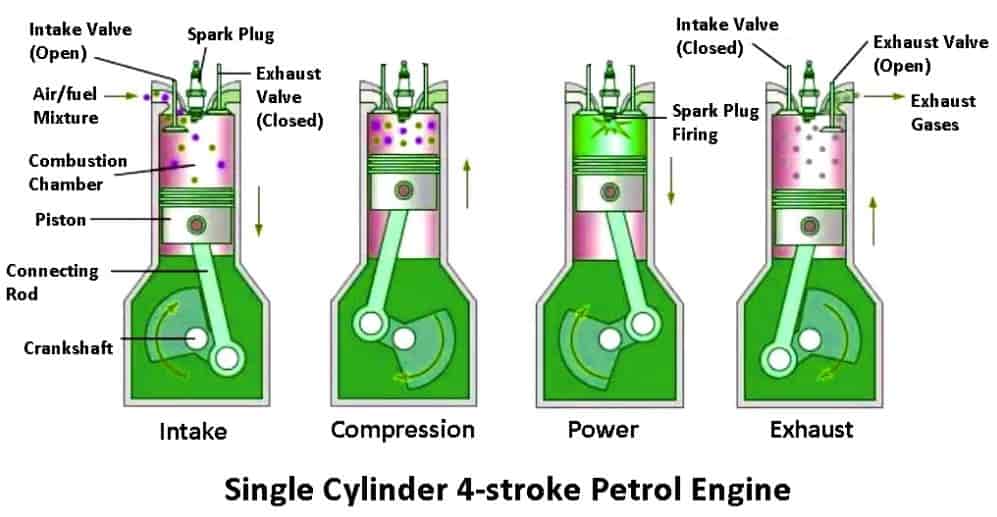
The petrol engine works on the principle of the otto cycle, also known as the constant volume cycle. In this engine, the spark plug fitted at the top of the cover initiates the ignition of the petrol.
All four strokes of a four-stroke engine take two crankshaft revolutions to complete each cycle: intake, compression, power, and exhaust. Let’s understand the strokes of the four-stroke engine.
#1 Intake Stroke
The intake stroke begins when the piston is at the TDC (top dead center). As the piston moves downward, the inlet valve gets open. A mixture of petrol and air vapors mixed proportionally by the carburetor enters the cylinder and fills the space in the cylinder. The piston reaches its lowest position, known as BDC (bottom dead center).
#2 Compression Stroke
In compression stroke, the piston again moves up after the intake stroke. When the piston moves upward, the inlet valve closes, and the exhaust valve remains closed. The piston compresses the air-fuel mixture by pushing it upward into the clearance space at the top of the cylinder, increasing the pressure and temperature of the mixture.
#3 Power Stroke
An air-fuel mixture at high pressure and temperature is ignited by a spark. The spark ignites the air-fuel mixture. As a result of this burning, the gases are subjected to further pressure and temperature increases. The gases expand, producing an explosive force pushing the piston down at high acceleration. Then the piston’s linear movement is converted into the rotary motion of the crankshaft.
#4 Exhaust Stroke
In this stroke, the piston reaches the bottom dead center (BDC), and opening the exhaust valve allows the burnt gases to escape at a higher rate. The piston moves up from the bottom center and pushes the remaining burnt gases inside the cylinder. The exhaust valve closes at the end of the exhaust stroke, and the cycle is repeated.
Read Also: What are Engine Valves? Types, Working and Uses
Single Cylinder 4-stroke Engine (Diesel Engine)
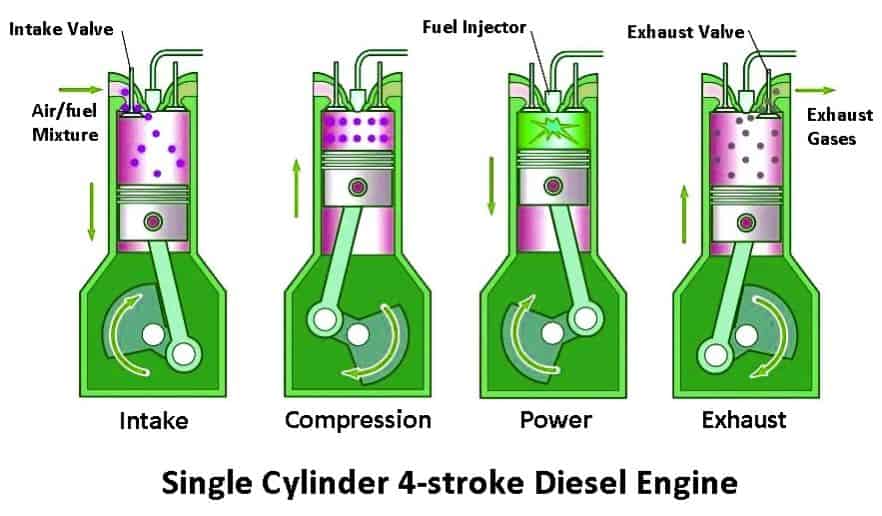
The basic construction of a four-stroke diesel engine is similar to that of a four-stroke petrol engine, except that a fuel injector is used instead of a spark plug. A fuel pump supplies the oil to the injector at higher pressure. It works on the principle of the diesel cycle or constant pressure cycle.
#1 Intake Stroke
In the intake stroke, the piston moves down, and the inlet valve opens, allowing air to enter the cylinder and fill the space. Now, the piston reaches the bottom center and starts moving upwards again.
#2 Compression Stroke
In the compression stroke, the piston begins to move upward, and the inlet valve closes. The pressure and temperature of the air increase due to the compression. Before the piston reaches the top dead center, diesel fuel is sprayed inside the cylinder.
With the aid of a fuel injector, fuel is sprayed at high pressure, exceeding the compressed air pressure. The fuel mixes with the air and contains oxygen. Fuel is a hydrocarbon, so when compressed air is heated to enough temperatures, combustion occurs, and the fuel is burned.
#3 Power Stroke
The piston moves from TDC to BDC in a power stroke. The heat from combustion further increases the pressure and temperature of the air. The maximum pressure and temperature of the burnt gases act on the top of the piston and force the piston to move downward. Before the piston reaches the BDC, the exhaust valve opens.
#4 Exhaust Stroke
The piston reaches BDC and starts moving upwards. Now, the burnt gases are being pushed out by the piston and leave through the exhaust valve. Before the piston reaches the TDC, the inlet valve is opened, and the cycle is repeated.
| 4-stroke Petrol Engine | 4-stroke Diesel Engine |
|---|---|
| It works on the principle of autocycle or constant volume cycle. | The diesel engine works on the diesel cycle or constant pressure cycle principle. |
| In this, the spark plug generates a spark to ignite the charge. | Whereas in a diesel engine, the fuel injector initiates the combustion. |
| In a petrol engine, petrol or gasoline is used as fuel. | Diesel is used as fuel in a diesel engine. |
| In this engine, the fuel mixes with the air inside the combustion chamber. | The fuel is mixed with air in the carburetor before it enters the combustion chamber. |
| Fuel consumption is less as the fuel used is thick. | Higher fuel consumption as compared to four-stroke diesel engines. |
| The design of this engine is more rigid due to the higher compression ratio. | Diesel engines are less rigid than four-stroke diesel engines. |
| A petrol engine is found in light-duty vehicles such as two-wheelers, cars, ATVs, etc. | Diesel engines are found in heavy-duty applications such as buses, trucks, agricultural tractors, etc. |
Read Also: Different Types of Turbochargers and Their Working [PDF]
Single Cylinder 2-stroke Engine (Petrol Engine)
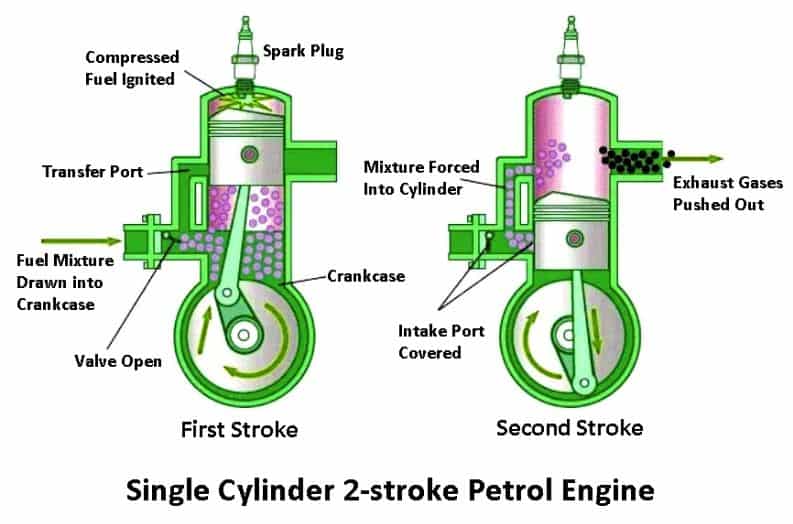
Two-stroke engines require one revolution of the crankshaft or two piston strokes to complete the cycle of events. The two-stroke engine works on the principle of the otto cycle or constant volume cycle.
#1 First Stroke
In this stroke, the piston is at its BDC position. During this stroke, the piston travels upwards from BDC to TDC, closing the transfer and exhaust ports. The mixture of charged air and petrol already in the cylinder is compressed.
The upward movement of the piston creates a partial vacuum in the crankcase, which allows a fresh charge to be drawn into the crankcase through the uncovered inlet port. The piston reaches TDC at the end of the stroke.
#2 Second Stroke
Before the end of the compression stroke, an electric spark created by the spark plug ignites the compressed air-fuel mixture in the combustion chamber. Due to the combustion, the piston is moved downward direction.
During this stroke, the piston covers the inlet port, and the fresh charge is compressed in the crankcase. As the piston continues to descend, the exhaust and transfer ports are opened.
Through the exhaust port, the compressed gases escape, and a new charge, which has already been compressed in the crankcase, is forced into the cylinder. When the charge strikes the deflector, the piston crown rises and pushes the exhaust gases out, repeating the cycle.
Read Also: What is the function of a flywheel in an engine?
Single Cylinder 2-stroke Engine (Diesel Engine)
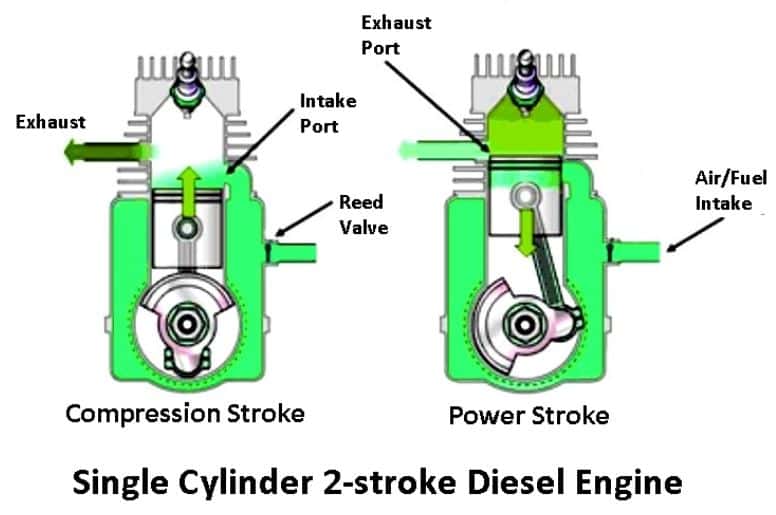
A 2-stroke diesel engine works the same way as a petrol engine but injects diesel at the end of the compression stroke. There is a charge of compressed air in the cylinder when the piston reaches its top.
The injector sprays diesel fuel into the cylinder and ignites immediately due to the heat and pressure inside the cylinder. The pressure generated by the combustion of the fuel drives the piston downward. This is called the power stroke.
As the piston nears the bottom of its stroke, the exhaust valve opens, and the exhaust gases exit the cylinder, relieving the pressure. When the piston moves bottom, it opens the air intake ports. Pressurized air fills the cylinder, forcing any remaining exhaust gases out.
After the exhaust valve closes, the piston moves upward again, recovering the intake ports and compressing the fresh air charge. This is known as a compression stroke. As the piston approaches the top of the cylinder, the cycle repeats.
Read Also: Different Types of Piston Rings & Their Functions
Advantages of Single Cylinder Engine
- These engines are usually compact and straightforward as compared to multi-cylinder engines.
- Air cooling is often more effective for single-cylinder engines because there is more airflow around the cylinders. Therefore, it reduces the weight and complexity of an air-cooled engine compared to a liquid-cooled engine.
- It is less expensive to manufacture the engine as it requires fewer components, and the overall weight is less.
- Single-cylinder engines produce high torque at low revs, making them more suitable for load lagging and applications requiring high torque.
- For any given cubic capacity, single-cylinder engines are more fuel efficient than twin-cylinder engines.
- Maintenance and repair of single-cylinder engines are simple due to their fewer moving parts and simple construction.
Disadvantages of Single Cylinder Engine
- Single-cylinder engines deliver more pulsating power and higher vibration levels through each cycle.
- This engine requires a heavy flywheel, resulting in relatively slow changes in engine speed.
- The single-cylinder engine isn’t the smoothest engine design to run on.
- Even though single-cylinder engines produce better torque in the low to mid revs, their maximum power output is not as much as a twin-cylinder engine.
- They cannot be used in applications over a specific cubic capacity because the components become too heavy and bulky for practical use.
Applications of Single-Cylinder Engine
Single-cylinder engines were common in early motorcycles, automobiles, and other applications such as marine engines. This design is only used in portable tools and garden machinery such as lawnmowers.
Apart from motorcycles, these engines are also used in motor scooters, go-karts, auto rickshaws, and radio-controlled models. Lanz Bulldog tractors were powered by horizontally-mounted single-cylinder two-stroke engines from 1921-1960.
The Honda Super Cub uses a 49 cc four-stroke single-cylinder engine. Many single-cylinder sportbikes use single-cylinder engines, such as the dual-sport motorcycle and the classic-styled Royal Enfield 500 Bullet.
Closing It Up
I hope I have covered everything about the “Single Cylinder Engine.” If I missed something, or if you have any doubts, let me know in the comments. If you liked this article, please share it with your friends.
Want free PDFs direct to your inbox? Then subscribe to our newsletter.
Download PDF of this article:
You might like to read more in our blog: